Higher Education: Reflective Learning and Assessment Improvement
VerifiedAdded on 2023/06/18
|8
|2065
|206
Essay
AI Summary
This essay provides a detailed exploration of reflective learning and its application in higher education. It defines reflection and reflective approaches to learning, emphasizing their role in developing critical thinking and improving future performance. The essay examines the nature of feedback and feedforward, highlighting their importance in guiding learning and preventing errors. It discusses how a reflective approach to feedback and feedforward can enhance future assessments through formative and summative evaluations. The Gibbs’s reflection model is presented as a structured framework for learning from experiences. The report concludes by emphasizing the benefits of timely and specific feedback for student improvement, and how platforms like Desklib can aid in accessing relevant study materials and past assignments.
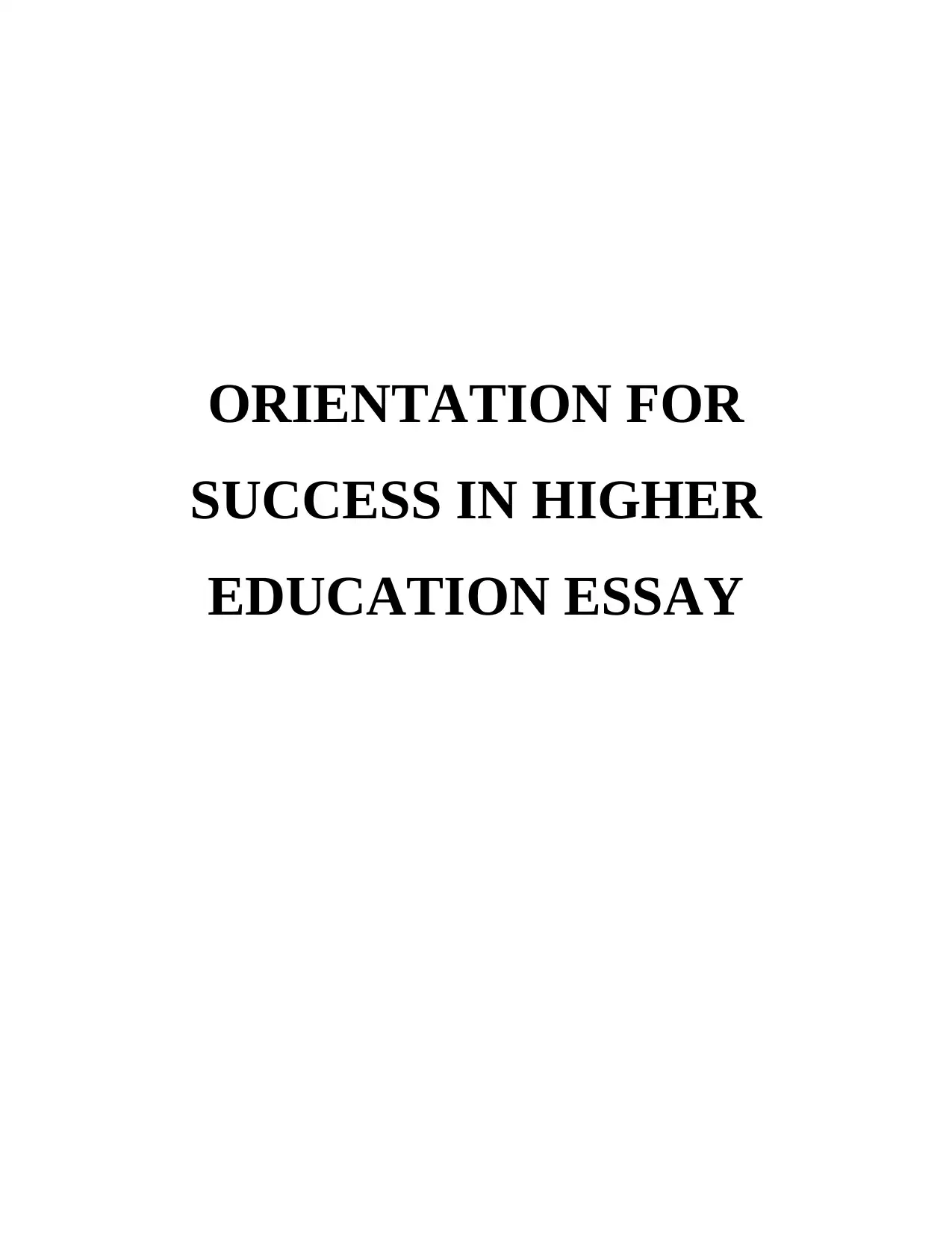
ORIENTATION FOR
SUCCESS IN HIGHER
EDUCATION ESSAY
SUCCESS IN HIGHER
EDUCATION ESSAY
Paraphrase This Document
Need a fresh take? Get an instant paraphrase of this document with our AI Paraphraser
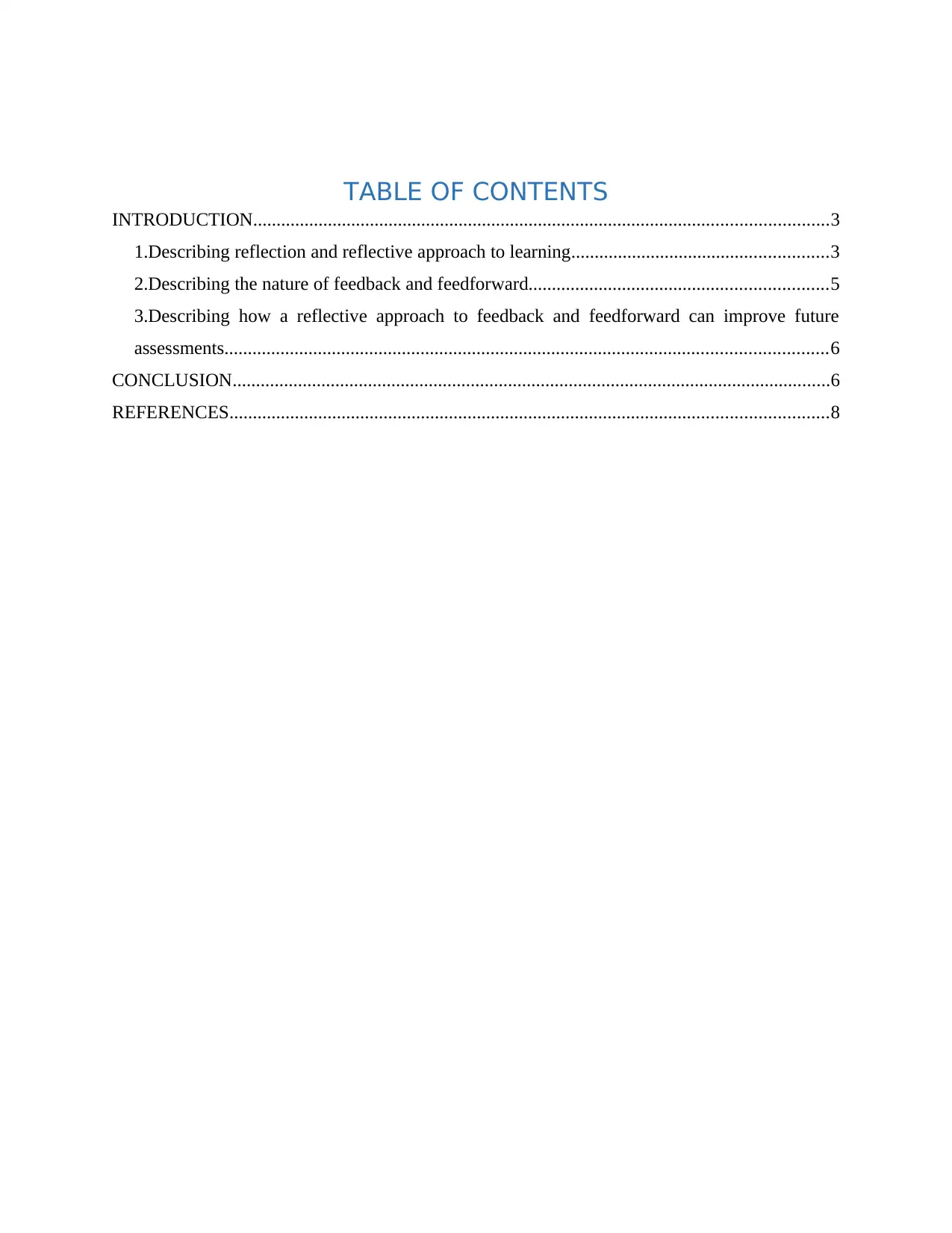
TABLE OF CONTENTS
INTRODUCTION...........................................................................................................................3
1.Describing reflection and reflective approach to learning.......................................................3
2.Describing the nature of feedback and feedforward................................................................5
3.Describing how a reflective approach to feedback and feedforward can improve future
assessments.................................................................................................................................6
CONCLUSION................................................................................................................................6
REFERENCES................................................................................................................................8
INTRODUCTION...........................................................................................................................3
1.Describing reflection and reflective approach to learning.......................................................3
2.Describing the nature of feedback and feedforward................................................................5
3.Describing how a reflective approach to feedback and feedforward can improve future
assessments.................................................................................................................................6
CONCLUSION................................................................................................................................6
REFERENCES................................................................................................................................8
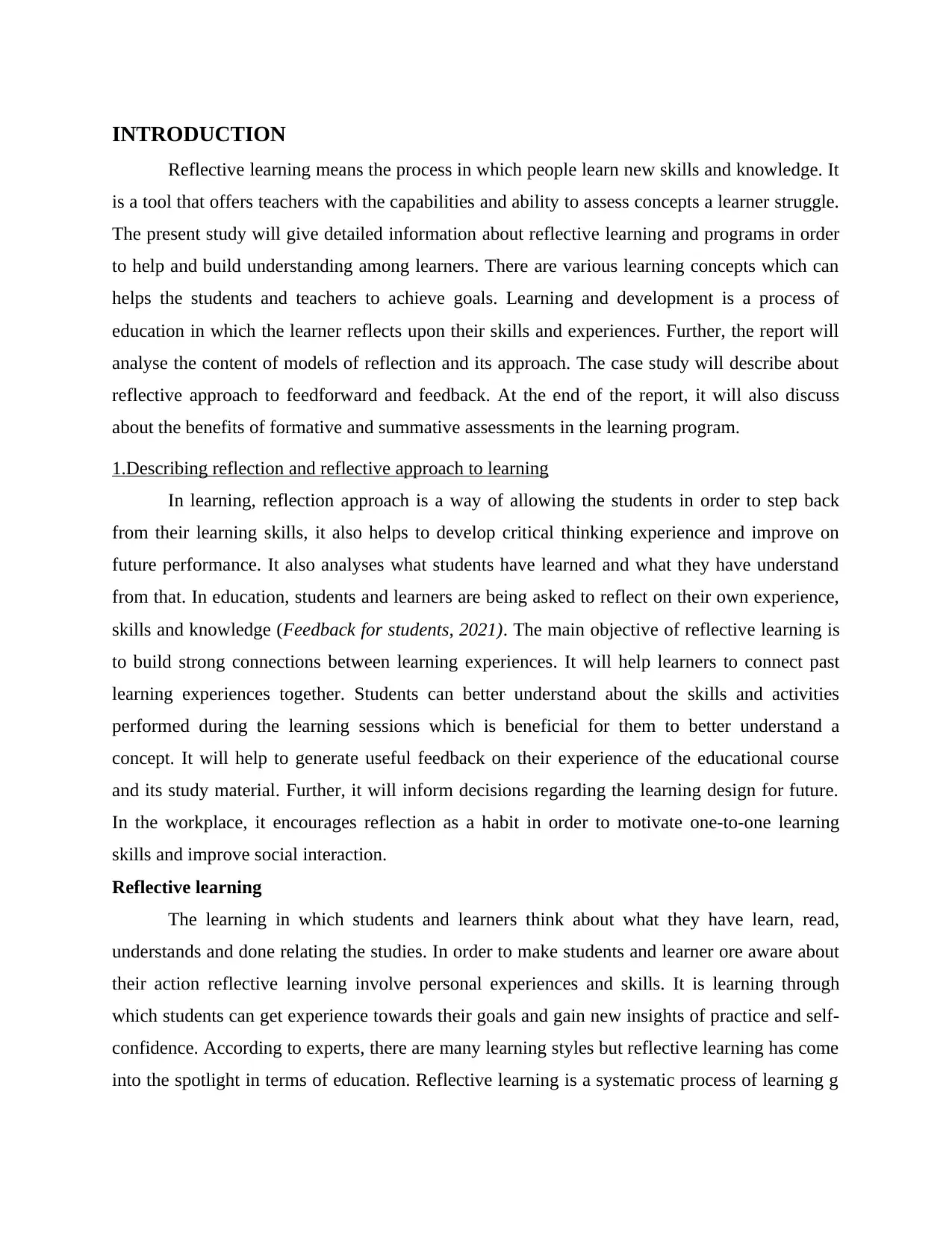
INTRODUCTION
Reflective learning means the process in which people learn new skills and knowledge. It
is a tool that offers teachers with the capabilities and ability to assess concepts a learner struggle.
The present study will give detailed information about reflective learning and programs in order
to help and build understanding among learners. There are various learning concepts which can
helps the students and teachers to achieve goals. Learning and development is a process of
education in which the learner reflects upon their skills and experiences. Further, the report will
analyse the content of models of reflection and its approach. The case study will describe about
reflective approach to feedforward and feedback. At the end of the report, it will also discuss
about the benefits of formative and summative assessments in the learning program.
1.Describing reflection and reflective approach to learning
In learning, reflection approach is a way of allowing the students in order to step back
from their learning skills, it also helps to develop critical thinking experience and improve on
future performance. It also analyses what students have learned and what they have understand
from that. In education, students and learners are being asked to reflect on their own experience,
skills and knowledge (Feedback for students, 2021). The main objective of reflective learning is
to build strong connections between learning experiences. It will help learners to connect past
learning experiences together. Students can better understand about the skills and activities
performed during the learning sessions which is beneficial for them to better understand a
concept. It will help to generate useful feedback on their experience of the educational course
and its study material. Further, it will inform decisions regarding the learning design for future.
In the workplace, it encourages reflection as a habit in order to motivate one-to-one learning
skills and improve social interaction.
Reflective learning
The learning in which students and learners think about what they have learn, read,
understands and done relating the studies. In order to make students and learner ore aware about
their action reflective learning involve personal experiences and skills. It is learning through
which students can get experience towards their goals and gain new insights of practice and self-
confidence. According to experts, there are many learning styles but reflective learning has come
into the spotlight in terms of education. Reflective learning is a systematic process of learning g
Reflective learning means the process in which people learn new skills and knowledge. It
is a tool that offers teachers with the capabilities and ability to assess concepts a learner struggle.
The present study will give detailed information about reflective learning and programs in order
to help and build understanding among learners. There are various learning concepts which can
helps the students and teachers to achieve goals. Learning and development is a process of
education in which the learner reflects upon their skills and experiences. Further, the report will
analyse the content of models of reflection and its approach. The case study will describe about
reflective approach to feedforward and feedback. At the end of the report, it will also discuss
about the benefits of formative and summative assessments in the learning program.
1.Describing reflection and reflective approach to learning
In learning, reflection approach is a way of allowing the students in order to step back
from their learning skills, it also helps to develop critical thinking experience and improve on
future performance. It also analyses what students have learned and what they have understand
from that. In education, students and learners are being asked to reflect on their own experience,
skills and knowledge (Feedback for students, 2021). The main objective of reflective learning is
to build strong connections between learning experiences. It will help learners to connect past
learning experiences together. Students can better understand about the skills and activities
performed during the learning sessions which is beneficial for them to better understand a
concept. It will help to generate useful feedback on their experience of the educational course
and its study material. Further, it will inform decisions regarding the learning design for future.
In the workplace, it encourages reflection as a habit in order to motivate one-to-one learning
skills and improve social interaction.
Reflective learning
The learning in which students and learners think about what they have learn, read,
understands and done relating the studies. In order to make students and learner ore aware about
their action reflective learning involve personal experiences and skills. It is learning through
which students can get experience towards their goals and gain new insights of practice and self-
confidence. According to experts, there are many learning styles but reflective learning has come
into the spotlight in terms of education. Reflective learning is a systematic process of learning g
⊘ This is a preview!⊘
Do you want full access?
Subscribe today to unlock all pages.

Trusted by 1+ million students worldwide
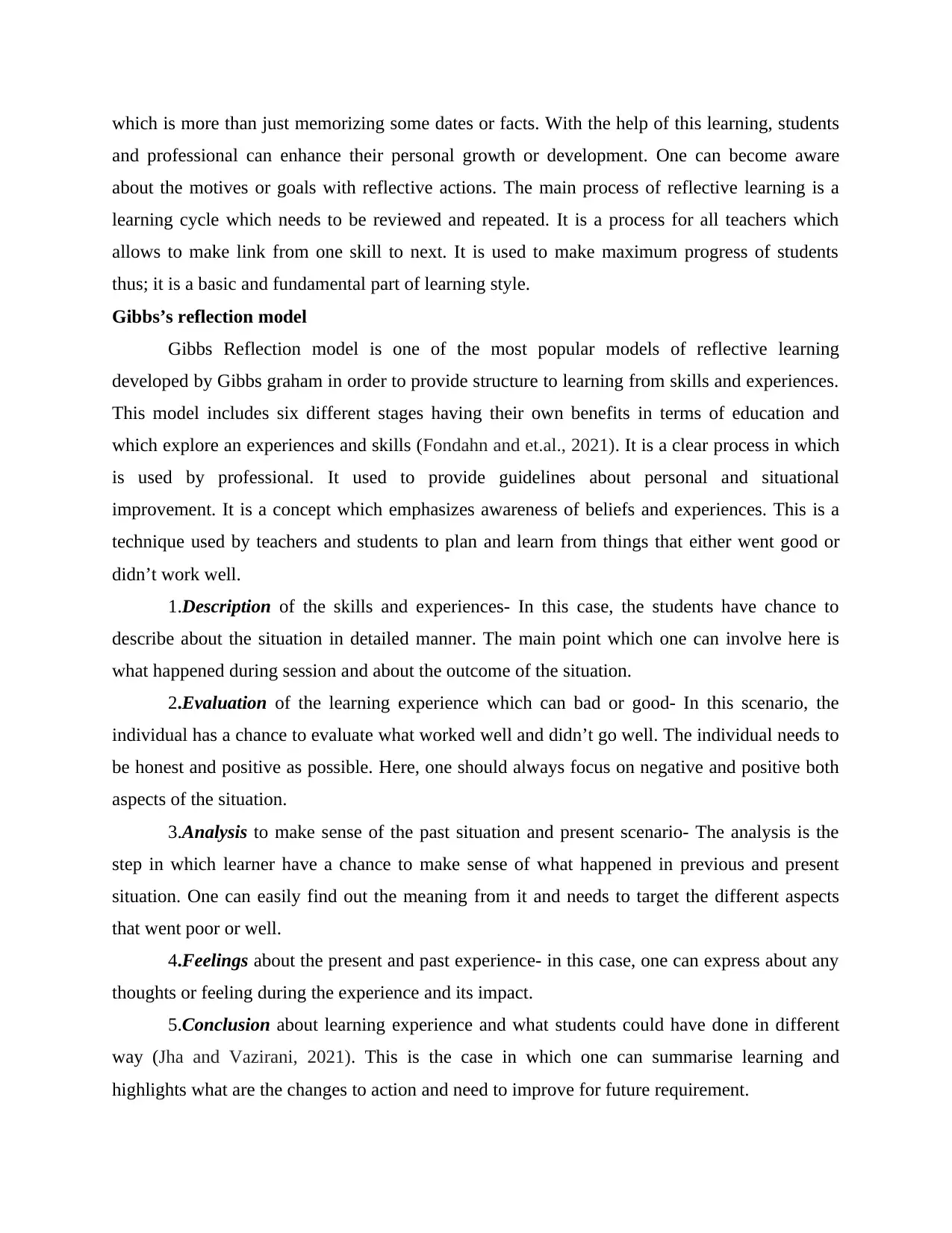
which is more than just memorizing some dates or facts. With the help of this learning, students
and professional can enhance their personal growth or development. One can become aware
about the motives or goals with reflective actions. The main process of reflective learning is a
learning cycle which needs to be reviewed and repeated. It is a process for all teachers which
allows to make link from one skill to next. It is used to make maximum progress of students
thus; it is a basic and fundamental part of learning style.
Gibbs’s reflection model
Gibbs Reflection model is one of the most popular models of reflective learning
developed by Gibbs graham in order to provide structure to learning from skills and experiences.
This model includes six different stages having their own benefits in terms of education and
which explore an experiences and skills (Fondahn and et.al., 2021). It is a clear process in which
is used by professional. It used to provide guidelines about personal and situational
improvement. It is a concept which emphasizes awareness of beliefs and experiences. This is a
technique used by teachers and students to plan and learn from things that either went good or
didn’t work well.
1.Description of the skills and experiences- In this case, the students have chance to
describe about the situation in detailed manner. The main point which one can involve here is
what happened during session and about the outcome of the situation.
2.Evaluation of the learning experience which can bad or good- In this scenario, the
individual has a chance to evaluate what worked well and didn’t go well. The individual needs to
be honest and positive as possible. Here, one should always focus on negative and positive both
aspects of the situation.
3.Analysis to make sense of the past situation and present scenario- The analysis is the
step in which learner have a chance to make sense of what happened in previous and present
situation. One can easily find out the meaning from it and needs to target the different aspects
that went poor or well.
4.Feelings about the present and past experience- in this case, one can express about any
thoughts or feeling during the experience and its impact.
5.Conclusion about learning experience and what students could have done in different
way (Jha and Vazirani, 2021). This is the case in which one can summarise learning and
highlights what are the changes to action and need to improve for future requirement.
and professional can enhance their personal growth or development. One can become aware
about the motives or goals with reflective actions. The main process of reflective learning is a
learning cycle which needs to be reviewed and repeated. It is a process for all teachers which
allows to make link from one skill to next. It is used to make maximum progress of students
thus; it is a basic and fundamental part of learning style.
Gibbs’s reflection model
Gibbs Reflection model is one of the most popular models of reflective learning
developed by Gibbs graham in order to provide structure to learning from skills and experiences.
This model includes six different stages having their own benefits in terms of education and
which explore an experiences and skills (Fondahn and et.al., 2021). It is a clear process in which
is used by professional. It used to provide guidelines about personal and situational
improvement. It is a concept which emphasizes awareness of beliefs and experiences. This is a
technique used by teachers and students to plan and learn from things that either went good or
didn’t work well.
1.Description of the skills and experiences- In this case, the students have chance to
describe about the situation in detailed manner. The main point which one can involve here is
what happened during session and about the outcome of the situation.
2.Evaluation of the learning experience which can bad or good- In this scenario, the
individual has a chance to evaluate what worked well and didn’t go well. The individual needs to
be honest and positive as possible. Here, one should always focus on negative and positive both
aspects of the situation.
3.Analysis to make sense of the past situation and present scenario- The analysis is the
step in which learner have a chance to make sense of what happened in previous and present
situation. One can easily find out the meaning from it and needs to target the different aspects
that went poor or well.
4.Feelings about the present and past experience- in this case, one can express about any
thoughts or feeling during the experience and its impact.
5.Conclusion about learning experience and what students could have done in different
way (Jha and Vazirani, 2021). This is the case in which one can summarise learning and
highlights what are the changes to action and need to improve for future requirement.
Paraphrase This Document
Need a fresh take? Get an instant paraphrase of this document with our AI Paraphraser
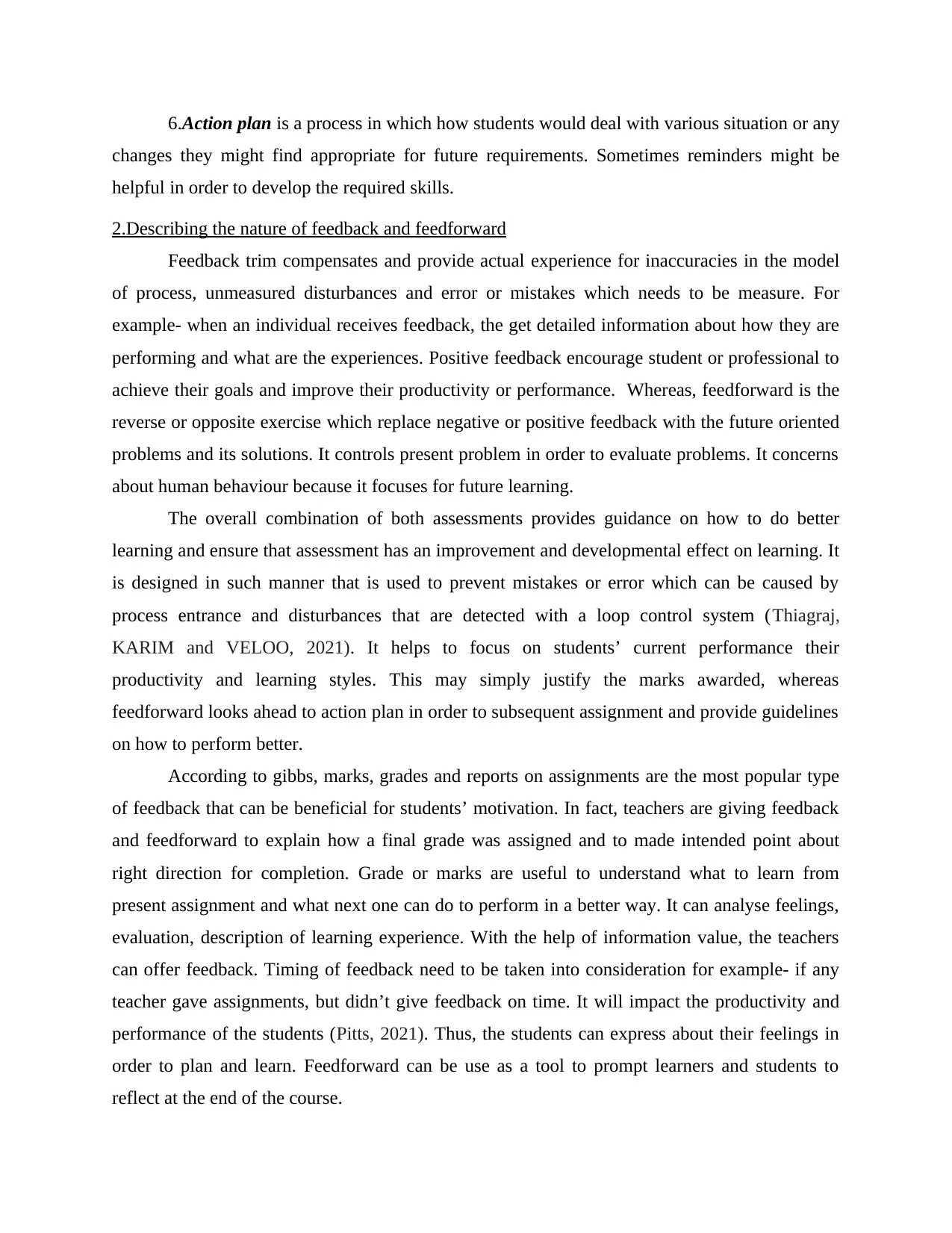
6.Action plan is a process in which how students would deal with various situation or any
changes they might find appropriate for future requirements. Sometimes reminders might be
helpful in order to develop the required skills.
2.Describing the nature of feedback and feedforward
Feedback trim compensates and provide actual experience for inaccuracies in the model
of process, unmeasured disturbances and error or mistakes which needs to be measure. For
example- when an individual receives feedback, the get detailed information about how they are
performing and what are the experiences. Positive feedback encourage student or professional to
achieve their goals and improve their productivity or performance. Whereas, feedforward is the
reverse or opposite exercise which replace negative or positive feedback with the future oriented
problems and its solutions. It controls present problem in order to evaluate problems. It concerns
about human behaviour because it focuses for future learning.
The overall combination of both assessments provides guidance on how to do better
learning and ensure that assessment has an improvement and developmental effect on learning. It
is designed in such manner that is used to prevent mistakes or error which can be caused by
process entrance and disturbances that are detected with a loop control system (Thiagraj,
KARIM and VELOO, 2021). It helps to focus on students’ current performance their
productivity and learning styles. This may simply justify the marks awarded, whereas
feedforward looks ahead to action plan in order to subsequent assignment and provide guidelines
on how to perform better.
According to gibbs, marks, grades and reports on assignments are the most popular type
of feedback that can be beneficial for students’ motivation. In fact, teachers are giving feedback
and feedforward to explain how a final grade was assigned and to made intended point about
right direction for completion. Grade or marks are useful to understand what to learn from
present assignment and what next one can do to perform in a better way. It can analyse feelings,
evaluation, description of learning experience. With the help of information value, the teachers
can offer feedback. Timing of feedback need to be taken into consideration for example- if any
teacher gave assignments, but didn’t give feedback on time. It will impact the productivity and
performance of the students (Pitts, 2021). Thus, the students can express about their feelings in
order to plan and learn. Feedforward can be use as a tool to prompt learners and students to
reflect at the end of the course.
changes they might find appropriate for future requirements. Sometimes reminders might be
helpful in order to develop the required skills.
2.Describing the nature of feedback and feedforward
Feedback trim compensates and provide actual experience for inaccuracies in the model
of process, unmeasured disturbances and error or mistakes which needs to be measure. For
example- when an individual receives feedback, the get detailed information about how they are
performing and what are the experiences. Positive feedback encourage student or professional to
achieve their goals and improve their productivity or performance. Whereas, feedforward is the
reverse or opposite exercise which replace negative or positive feedback with the future oriented
problems and its solutions. It controls present problem in order to evaluate problems. It concerns
about human behaviour because it focuses for future learning.
The overall combination of both assessments provides guidance on how to do better
learning and ensure that assessment has an improvement and developmental effect on learning. It
is designed in such manner that is used to prevent mistakes or error which can be caused by
process entrance and disturbances that are detected with a loop control system (Thiagraj,
KARIM and VELOO, 2021). It helps to focus on students’ current performance their
productivity and learning styles. This may simply justify the marks awarded, whereas
feedforward looks ahead to action plan in order to subsequent assignment and provide guidelines
on how to perform better.
According to gibbs, marks, grades and reports on assignments are the most popular type
of feedback that can be beneficial for students’ motivation. In fact, teachers are giving feedback
and feedforward to explain how a final grade was assigned and to made intended point about
right direction for completion. Grade or marks are useful to understand what to learn from
present assignment and what next one can do to perform in a better way. It can analyse feelings,
evaluation, description of learning experience. With the help of information value, the teachers
can offer feedback. Timing of feedback need to be taken into consideration for example- if any
teacher gave assignments, but didn’t give feedback on time. It will impact the productivity and
performance of the students (Pitts, 2021). Thus, the students can express about their feelings in
order to plan and learn. Feedforward can be use as a tool to prompt learners and students to
reflect at the end of the course.
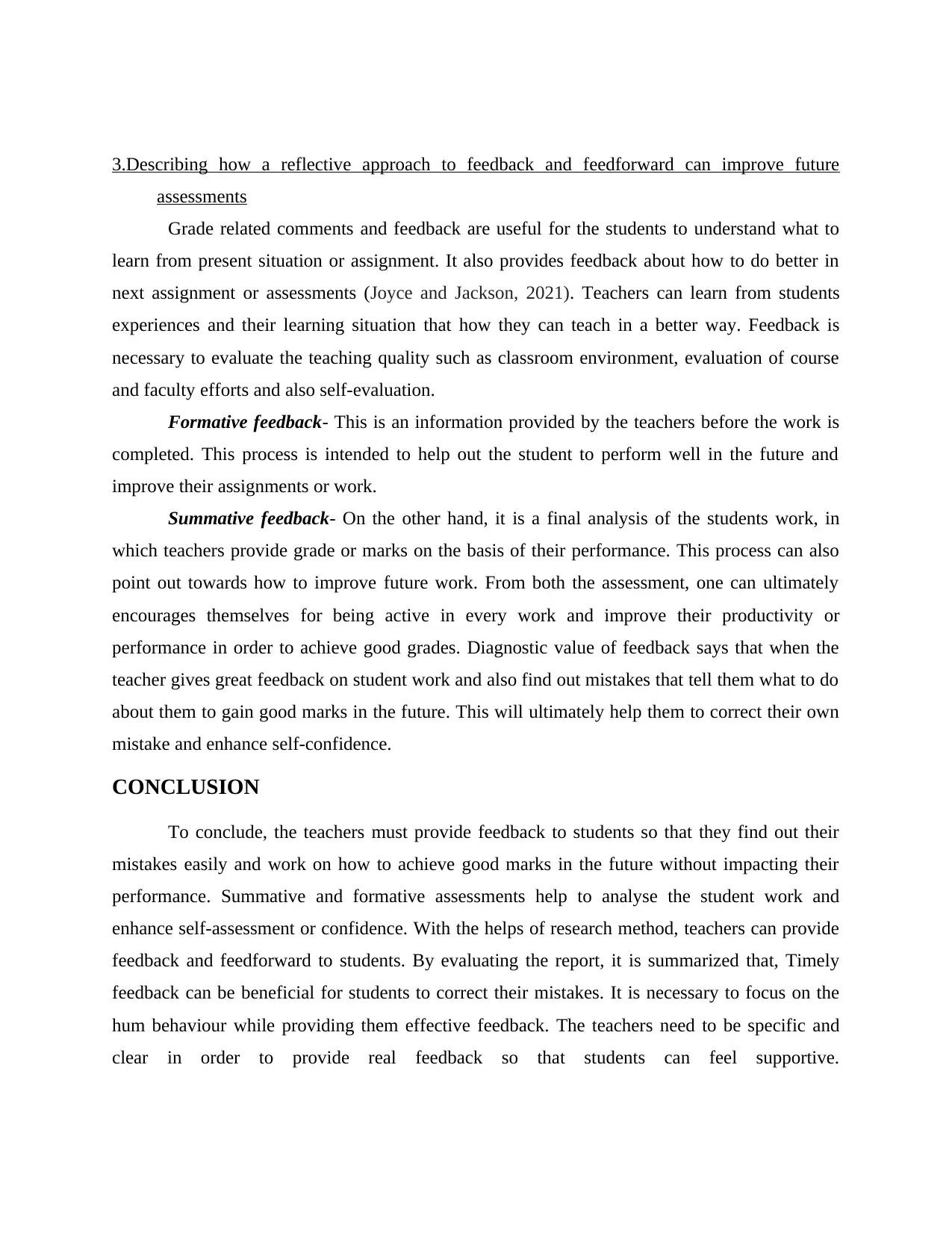
3.Describing how a reflective approach to feedback and feedforward can improve future
assessments
Grade related comments and feedback are useful for the students to understand what to
learn from present situation or assignment. It also provides feedback about how to do better in
next assignment or assessments (Joyce and Jackson, 2021). Teachers can learn from students
experiences and their learning situation that how they can teach in a better way. Feedback is
necessary to evaluate the teaching quality such as classroom environment, evaluation of course
and faculty efforts and also self-evaluation.
Formative feedback- This is an information provided by the teachers before the work is
completed. This process is intended to help out the student to perform well in the future and
improve their assignments or work.
Summative feedback- On the other hand, it is a final analysis of the students work, in
which teachers provide grade or marks on the basis of their performance. This process can also
point out towards how to improve future work. From both the assessment, one can ultimately
encourages themselves for being active in every work and improve their productivity or
performance in order to achieve good grades. Diagnostic value of feedback says that when the
teacher gives great feedback on student work and also find out mistakes that tell them what to do
about them to gain good marks in the future. This will ultimately help them to correct their own
mistake and enhance self-confidence.
CONCLUSION
To conclude, the teachers must provide feedback to students so that they find out their
mistakes easily and work on how to achieve good marks in the future without impacting their
performance. Summative and formative assessments help to analyse the student work and
enhance self-assessment or confidence. With the helps of research method, teachers can provide
feedback and feedforward to students. By evaluating the report, it is summarized that, Timely
feedback can be beneficial for students to correct their mistakes. It is necessary to focus on the
hum behaviour while providing them effective feedback. The teachers need to be specific and
clear in order to provide real feedback so that students can feel supportive.
assessments
Grade related comments and feedback are useful for the students to understand what to
learn from present situation or assignment. It also provides feedback about how to do better in
next assignment or assessments (Joyce and Jackson, 2021). Teachers can learn from students
experiences and their learning situation that how they can teach in a better way. Feedback is
necessary to evaluate the teaching quality such as classroom environment, evaluation of course
and faculty efforts and also self-evaluation.
Formative feedback- This is an information provided by the teachers before the work is
completed. This process is intended to help out the student to perform well in the future and
improve their assignments or work.
Summative feedback- On the other hand, it is a final analysis of the students work, in
which teachers provide grade or marks on the basis of their performance. This process can also
point out towards how to improve future work. From both the assessment, one can ultimately
encourages themselves for being active in every work and improve their productivity or
performance in order to achieve good grades. Diagnostic value of feedback says that when the
teacher gives great feedback on student work and also find out mistakes that tell them what to do
about them to gain good marks in the future. This will ultimately help them to correct their own
mistake and enhance self-confidence.
CONCLUSION
To conclude, the teachers must provide feedback to students so that they find out their
mistakes easily and work on how to achieve good marks in the future without impacting their
performance. Summative and formative assessments help to analyse the student work and
enhance self-assessment or confidence. With the helps of research method, teachers can provide
feedback and feedforward to students. By evaluating the report, it is summarized that, Timely
feedback can be beneficial for students to correct their mistakes. It is necessary to focus on the
hum behaviour while providing them effective feedback. The teachers need to be specific and
clear in order to provide real feedback so that students can feel supportive.
⊘ This is a preview!⊘
Do you want full access?
Subscribe today to unlock all pages.

Trusted by 1+ million students worldwide

Paraphrase This Document
Need a fresh take? Get an instant paraphrase of this document with our AI Paraphraser
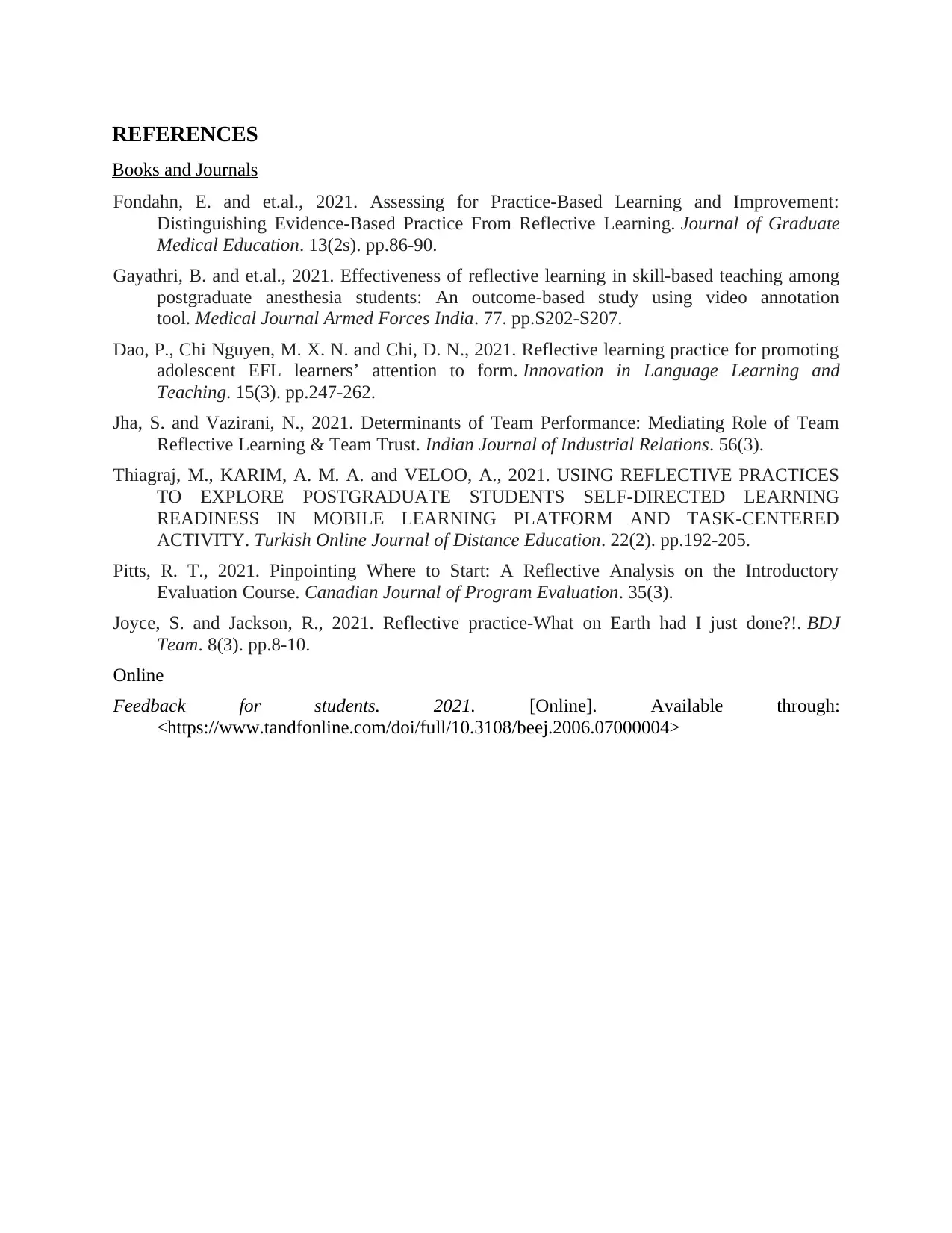
REFERENCES
Books and Journals
Fondahn, E. and et.al., 2021. Assessing for Practice-Based Learning and Improvement:
Distinguishing Evidence-Based Practice From Reflective Learning. Journal of Graduate
Medical Education. 13(2s). pp.86-90.
Gayathri, B. and et.al., 2021. Effectiveness of reflective learning in skill-based teaching among
postgraduate anesthesia students: An outcome-based study using video annotation
tool. Medical Journal Armed Forces India. 77. pp.S202-S207.
Dao, P., Chi Nguyen, M. X. N. and Chi, D. N., 2021. Reflective learning practice for promoting
adolescent EFL learners’ attention to form. Innovation in Language Learning and
Teaching. 15(3). pp.247-262.
Jha, S. and Vazirani, N., 2021. Determinants of Team Performance: Mediating Role of Team
Reflective Learning & Team Trust. Indian Journal of Industrial Relations. 56(3).
Thiagraj, M., KARIM, A. M. A. and VELOO, A., 2021. USING REFLECTIVE PRACTICES
TO EXPLORE POSTGRADUATE STUDENTS SELF-DIRECTED LEARNING
READINESS IN MOBILE LEARNING PLATFORM AND TASK-CENTERED
ACTIVITY. Turkish Online Journal of Distance Education. 22(2). pp.192-205.
Pitts, R. T., 2021. Pinpointing Where to Start: A Reflective Analysis on the Introductory
Evaluation Course. Canadian Journal of Program Evaluation. 35(3).
Joyce, S. and Jackson, R., 2021. Reflective practice-What on Earth had I just done?!. BDJ
Team. 8(3). pp.8-10.
Online
Feedback for students. 2021. [Online]. Available through:
<https://www.tandfonline.com/doi/full/10.3108/beej.2006.07000004>
Books and Journals
Fondahn, E. and et.al., 2021. Assessing for Practice-Based Learning and Improvement:
Distinguishing Evidence-Based Practice From Reflective Learning. Journal of Graduate
Medical Education. 13(2s). pp.86-90.
Gayathri, B. and et.al., 2021. Effectiveness of reflective learning in skill-based teaching among
postgraduate anesthesia students: An outcome-based study using video annotation
tool. Medical Journal Armed Forces India. 77. pp.S202-S207.
Dao, P., Chi Nguyen, M. X. N. and Chi, D. N., 2021. Reflective learning practice for promoting
adolescent EFL learners’ attention to form. Innovation in Language Learning and
Teaching. 15(3). pp.247-262.
Jha, S. and Vazirani, N., 2021. Determinants of Team Performance: Mediating Role of Team
Reflective Learning & Team Trust. Indian Journal of Industrial Relations. 56(3).
Thiagraj, M., KARIM, A. M. A. and VELOO, A., 2021. USING REFLECTIVE PRACTICES
TO EXPLORE POSTGRADUATE STUDENTS SELF-DIRECTED LEARNING
READINESS IN MOBILE LEARNING PLATFORM AND TASK-CENTERED
ACTIVITY. Turkish Online Journal of Distance Education. 22(2). pp.192-205.
Pitts, R. T., 2021. Pinpointing Where to Start: A Reflective Analysis on the Introductory
Evaluation Course. Canadian Journal of Program Evaluation. 35(3).
Joyce, S. and Jackson, R., 2021. Reflective practice-What on Earth had I just done?!. BDJ
Team. 8(3). pp.8-10.
Online
Feedback for students. 2021. [Online]. Available through:
<https://www.tandfonline.com/doi/full/10.3108/beej.2006.07000004>
1 out of 8
Related Documents
Your All-in-One AI-Powered Toolkit for Academic Success.
+13062052269
info@desklib.com
Available 24*7 on WhatsApp / Email
![[object Object]](/_next/static/media/star-bottom.7253800d.svg)
Unlock your academic potential
Copyright © 2020–2025 A2Z Services. All Rights Reserved. Developed and managed by ZUCOL.

